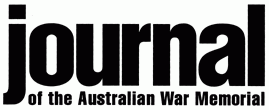Issue 40

No.40– February 2007
Contents
In this issue
Papers from the conference “ANZAC Day to VP Day: arguments and interpretations”, July 2005
Keynote address
ANZAC Day to VP Day: arguments and interpretations
Joan Beaumont
This paper offers a survey of recent military historiography. The author considers its fragmentary nature, and argues for integrative and comparative approach.
The Palestine Campaign 1916–18: causes and consequences of a continuing historical neglect
Jean Bou
There has, in recent years, been a vigorous and enthusiastic process of historical revisionism relating to British and Dominion armies fighting on the Western Front during the Great War. Focussing on this undoubtedly key theatre has inevitably meant that some aspects of the conflict have not had the attention that they perhaps deserve. The Palestine Campaign falls into this category and despite some efforts in recent years the history of this campaign has been largely left to the version of events established by the official histories. This paper will look into this and consider its implications.
Soldiers’ journeys: returning to the battlefields of the Great War
Bruce Scates
Well before the Great War ended, its battlefields and cemeteries became a site of pilgrimage. This paper will explore soldiers’ journeys across the “warscapes” of Gallipoli, France, Belgium, Egypt, and Palestine. It will chart both individual journeys and the mass pilgrimages that departed from Australia and Britain in the 1920s and 1930s. Pilgrimage will be presented as an inter-generational phenomenon, comparing the responses of Great War veterans to those of former servicemen and women who embark on these pilgrimages today.
Memory, methodology, and myth: some of the challenges of writing Australian prisoner of war history
Rosalind Hearder
Writing about Australian prisoners of war of the Japanese during the Second World War presents a unique set of methodological challenges for a historian. This paper will explore some of these challenges, such as the influence of trauma and group loyalty on the memories of former prisoners of war, and the problems of corroborating testimony in a field where documentation is limited. It will also discuss those individual Australian former prisoners of war and particular experiences that have become the iconic representations of captivity, resulting in a one-dimensional mythology that continues to be perpetuated about the experience.
Other articles
War, flowers, and visual culture: the First World War collection of the Australian War Memorial
Ann Elias
Flowers are traditionally connected with beauty, purity, and life, but they are mutable signs. In war, a context in which they have a long association, flowers readily conjure up abject violence. Flowers can simultaneously symbolise hope as well as grief. The collection of the Australian War Memorial is the focus of this article. Its range of objects reveals the cultural complexity of flowers to the politics and poetics of the First World War.
“Unconscious of any distinction”? Social and vocational quality in the Australian Flying Corps, 1914–18
Michael Molkentin
This article continues a scholarly tradition of examining the social structures of Australia’s military forces. It challenges this view that has been a significant feature of the ANZAC myth, namely in popular assumptions that the Australian Imperial Force (AIF) during the First World War was characterised by egalitarianism and democracy. A study of the Australian Flying Corps (AFC), however, reveals a very different picture. The AFC’s officers and men typically possessed a level of professional training and education that was disproportionate to both the AIF as a whole and Australia’s working male population. This study of the AFC suggests that “specialist units” of the AIF socially and culturally challenged the concept of the democratic ANZAC, particularly regarding class and regional structure.
Review
Tadeusz Dubicki, Daria Nalecz & Tessa Stirling (eds.), Intelligence Co-operation between Poland and Great Britain during World War II, Vallentine-Mitchell, London, 2005, xxiii + 586 pp., illustrations, index, hard cover, ₤55.00
Reviewer: Chris Clark